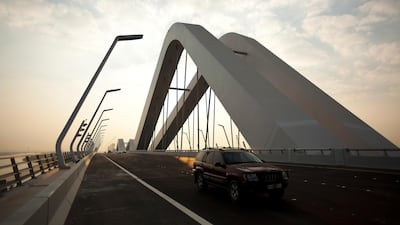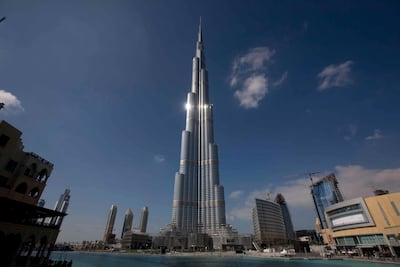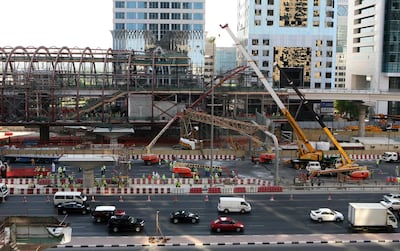When The National was launched in 2008, the UAE was best known for spectacular building projects: an indoor ski slope, and islands shaped like continents and palms.
The rate of construction was so remarkable that an urban myth was told of a Keralite crane operator named Babu Sassi, whose crane on the Burj Dubai was so tall that he lived in the cab at the top.
At the time it was widely reported that Dubai was home to a quarter of the world’s 125,000 cranes. (It was actually no more than 2 per cent.)
Building and infrastructure would transform the landscape and social fabric of the country over the next decade in a manner made more astonishing by the backdrop of the 2008 global financial crisis and the Arab uprisings.
The month The National was launched the Burj Dubai, as it was then known, reached level 160 and became the world's tallest man-made structure. But within a few months, the effects of the 2008 global financial crisis hit.
Major infrastructure projects including the 52-kilometre Metro, enabled the city to withstand the effects of the crisis, says Dr Yasser Elsheshtawy, an architect, historian and former professor of architecture at the UAE University. It would open a year later in September, 2009.
"It is as if the city's central nervous system is starting to shoot signals to previously detached limbs," National reporter Hugh Naylor wrote at the time.
A 14.5km tramline followed in 2014, connecting Sheikh Zayed Road with the Marina and Palm Jumeirah, and even now construction continues with a 15km extension to the emirate’s next big project – Dubai 2020 Expo.
The city is undergoing a renewed inward focus, Dr Elsheshtawy says, with projects such as the new creekside retail area of Marsa Al Seef. After a proliferation of malls, Dubai is now tending towards pedestrian-friendly, open-air retail outlets.
“In many ways the past 10 years have witnessed a maturation of the real estate market and a closer focus on livability – walkable areas, outdoor places for social interaction and mixed-use developments,” Dr Elsheshtawy says.
“A proliferation of cultural projects moves the urban development paradigm away from a profit-making paradigm.
"While admirable in many ways, there is a clear tendency towards focusing on the higher-end of the market, and the immediate impact and relation to the existing city is sometimes not studied carefully." Abu Dhabi
In 2008, Abu Dhabi’s Urban Planning Council began to implement Plan 2030, starting the capital’s transformation from an island city to a city of islands.
When The National was launched, there were two crossings into the city – the Maqta and Mussaffah bridges. But there were plans for 32 more connecting the main island with Reem, Maryah, Yas and Saadiyat islands.
The 10-lane, 1.4km Sheikh Khalifa bridge to Saadiyat opened in October 2009, just before the first Formula One GP on Yas Island. It connected the Corniche to Saadiyat Island, Yas and the E11.
The mainland satellites of Khalifa City, Mohammed bin Zayed City and Mussaffah were linked to the Corniche by the 2010 opening of the 800-metre Sheikh Zayed Bridge, designed by celebrated British-Iraqi architect Zaha Hadid.
In late 2012, the much-anticipated, Dh5 billion Salam Street expressway, later to be renamed after the Founding Father, Sheikh Zayed, was completed after more than five years of construction.
Meanwhile, 80 metres underground, the Dh5.7bn Strategic Tunnel Enhancement Programme was under way. With 91km of sewers, it is one of the longest gravity-driven wastewater tunnels in the world.
Changes were not without growing pains. In its early years, The National reported extensively on the effects of the Salam Street tunnel building and another infrastructural innovation – paid parking. The Mawaqif paid parking scheme was introduced in October 2009. As parking lots were plotted out, drivers spent evenings circling for hours.
“It wasn’t ever intended to be a revenue-generating operation. It was a way to get all these cars off the streets,” says Dr Jane Bristol-Rhys, an associate professor of anthropology at Zayed University.
In the Western Region, later renamed Al Dhafra, life improved with the upgrade of the 327km Mafraq-Ghweifat motorway to the Saudi border.
In 2014, the region launched the country’s first railway and commercial operations began on the 264km line from the Shah oil and gasfields to Ruwais port. Plans for a trans-Gulf passenger line were held.
Running in the opposite direction, from sea to desert, is a water pipeline to the 21 billion litre underground reservoir in the Liwa desert near the Empty Quarter. The Dh1.6bn project, finished in January, is the world’s largest reserve of high-quality desalinated water.
_____________
Read more of our 10-year anniversary coverage here:
SPECIAL REPORT: Chronicling 10 years of change in the UAE
The art of institution building
Then and Now: A decade of remarkable growth in every direction imaginable
A decade of media experimentation
Technology has transformed every aspect of life in UAE
____________
Northern Emirates
Meanwhile, the Northern Emirates were left in darkness. In 2008, the north was experiencing electricity and water shortages that would continue for another three years.
In 2010, a Federal National Council investigation found about 1,000 buildings in the Northern Emirates lacked access to the Federal Electricity and Water Authority grid. Sharjah, on its own grid, experienced power cuts that played a part in at least one death.
Roads were poor and congested with industrial traffic.
All of this changed with a tour by Sheikh Mohammed bin Zayed, Crown Prince of Abu Dhabi and Deputy Commander of the Armed Forces, of the Northern Emirates in February 2011.
Weeks later, the federal government committed Dh5.7bn to water and electricity infrastructure in the Northern Emirates and approved the building of 667 villas.
Hospitals and clinics, sewage plants, water pipelines and roads were ordered. In Ras Al Khaimah, 300km of internal roads ordered by the President, Sheikh Khalifa, and Sheikh Mohammed were completed by September 2013.
The country had already been connected by the 2010 completion of the 72km Dubai bypass motorway that ran from Sharjah to Abu Dhabi.
Dunes were flattened for rapidly expanding suburbs with thousands of state-funded housing grants. RAK’s Public Works Department prepared 5,000 plots in 2013 with 10,000 more planned for late 2014. In Fujairah, construction of the Dh17bn Mohammed bin Zayed City project for 10,000 families began in March 2016.
Fujairah received a boost in July 2012 with completion of a $3.3bn pipeline laid across 403km of mountains and sabkha salt flats from from Abu Dhabi’s oilfields to the Gulf of Oman, allowing crude to bypass the Strait of Hormuz.
Back in RAK, the 2013 opening of the 36km Jebel Jais Road opened the wadis to the public, boosted tourism and had local owners building fences.
The investment in infrastructure has had other intangible affects on national cohesion, just as it did when Sheikh Zayed rebuilt the falaj irrigation networks in Al Ain.
It will have an equally significant impact on how the country is defined in future, physically and socially.
With talk of a hyperloop, flying taxis and AI-surveillance, it is a future no less strange than the tall tales told in 2008.



